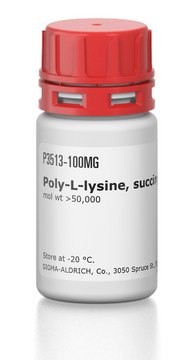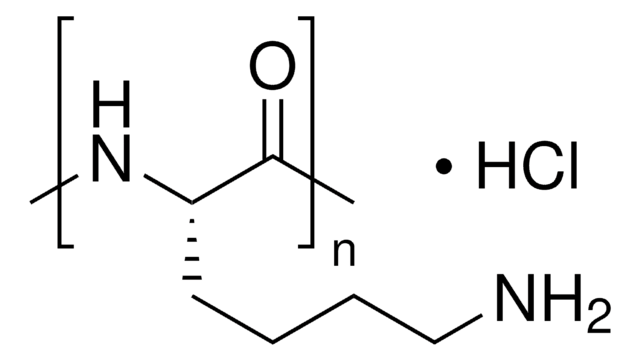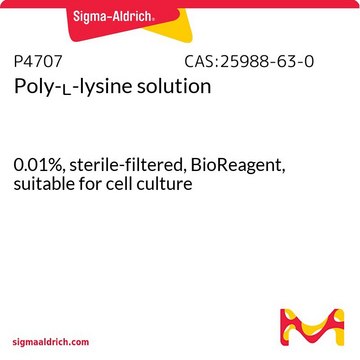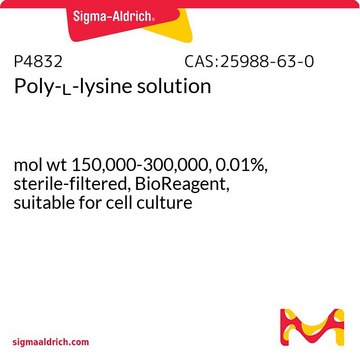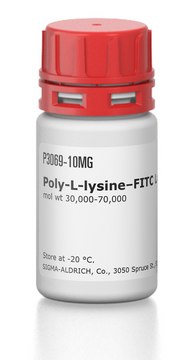P4510
Poly-ε-Cbz-L-lysine
mol wt 500-4,000
Synonym(s):
N6-[(phenylmethoxy)carbonyl]-L-lysine homopolymer
About This Item
Recommended Products
form
powder
Quality Level
mol wt
500-4,000
color
white
storage temp.
−20°C
SMILES string
[N+H3][C@@H](CCCCNC(=O)OCc1ccccc1)C(=O)[O-]
InChI
1S/C14H20N2O4/c15-12(13(17)18)8-4-5-9-16-14(19)20-10-11-6-2-1-3-7-11/h1-3,6-7,12H,4-5,8-10,15H2,(H,16,19)(H,17,18)/t12-/m0/s1
InChI key
CKGCFBNYQJDIGS-LBPRGKRZSA-N
Looking for similar products? Visit Product Comparison Guide
Application
- Transfection by polyethyleneimine-coated microspheres.: This study explores the use of Poly-e-Cbz-L-lysine in coating microspheres with polyethyleneimine for enhanced cell transfection, demonstrating improved efficiency and potential applications in gene therapy (Manuel WS et al., 2001).
- Transfection of cells mediated by biodegradable polymer materials with surface-bound polyethyleneimine.: The research focuses on biodegradable polymer materials, including Poly-e-Cbz-L-lysine, for cell transfection, highlighting their biodegradability and effectiveness in delivering genetic material (Zheng J et al., 2000).
- Production of microspheres with surface amino groups from blends of Poly(Lactide-co-glycolide) and Poly(epsilon-CBZ-L-lysine) and use for encapsulation.: This paper discusses the creation of microspheres with surface amino groups using blends of Poly-e-Cbz-L-lysine, which are then used for encapsulating active agents, indicating applications in drug delivery systems (Zheng J et al., 1999).
- Modification of materials formed from poly(L-lactic acid) to enable covalent binding of biopolymers: application to high-density three-dimensional cell culture in foams with attached collagen.: The study examines the modification of poly(L-lactic acid) materials with Poly-e-Cbz-L-lysine to covalently bind biopolymers, facilitating high-density 3D cell culture applications (Zheng J et al., 1998).
Analysis Note
Other Notes
Storage Class Code
11 - Combustible Solids
WGK
WGK 3
Flash Point(F)
Not applicable
Flash Point(C)
Not applicable
Personal Protective Equipment
Choose from one of the most recent versions:
Already Own This Product?
Find documentation for the products that you have recently purchased in the Document Library.
Which document(s) contains shelf-life or expiration date information for a given product?
If available for a given product, the recommended re-test date or the expiration date can be found on the Certificate of Analysis.
How do I get lot-specific information or a Certificate of Analysis?
The lot specific COA document can be found by entering the lot number above under the "Documents" section.
How do I find price and availability?
There are several ways to find pricing and availability for our products. Once you log onto our website, you will find the price and availability displayed on the product detail page. You can contact any of our Customer Sales and Service offices to receive a quote. USA customers: 1-800-325-3010 or view local office numbers.
What is the Department of Transportation shipping information for this product?
Transportation information can be found in Section 14 of the product's (M)SDS.To access the shipping information for this material, use the link on the product detail page for the product.
Product P4510, Poly-ε-Cbz-L-lysine has a Cbz (carbobenzoxy) protecting group on the ε-amino group of each lysine. What are the structures of the α-amino-terminus and the carboxy-terminus, and are the end groups detectable by NMR?
The end groups are free amino (-NH2) and carboxyl (-COOH). Because this a polydisperse material, it would be difficult to detect distinctive end groups via NMR.
My question is not addressed here, how can I contact Technical Service for assistance?
Ask a Scientist here.
Articles
Humankind has utilized protein materials throughout its existence, starting with the use of materials such as wool and silk for warmth and protection from the elements and continuing with the use of recombinant DNA techniques to synthesize proteins with unique and useful properties.
Our team of scientists has experience in all areas of research including Life Science, Material Science, Chemical Synthesis, Chromatography, Analytical and many others.
Contact Technical Service